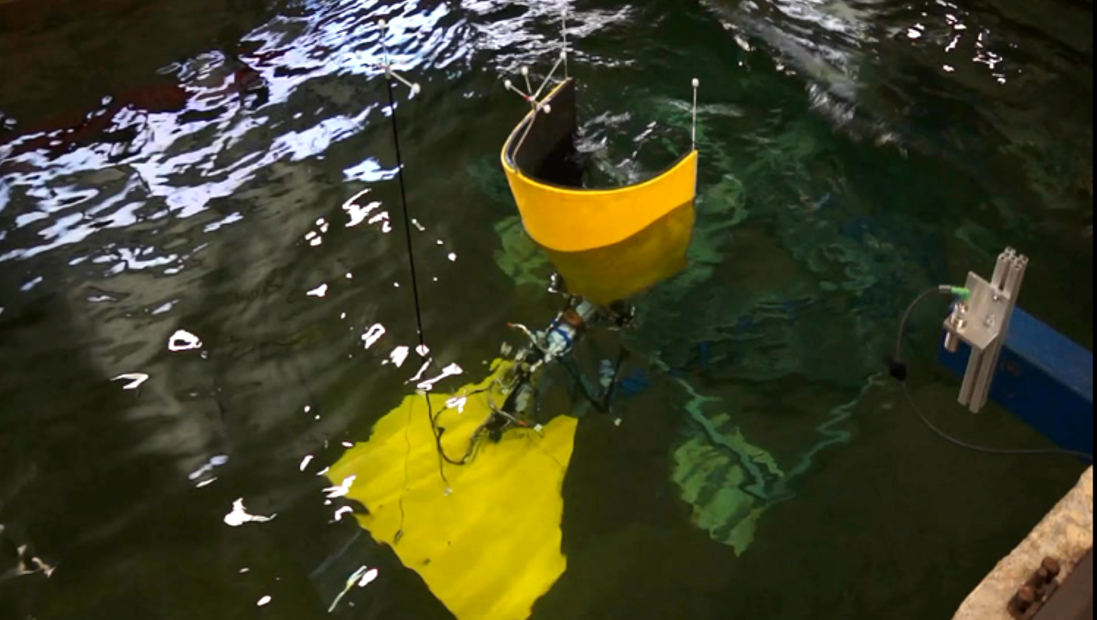Mid-stage development of the CCell Wave Energy Converter
This project seeks to develop and test prototype systems in renewable energy using ocean waves as a viable renewable alternative to conventional energy sources.

The project aims to demonstrate cost-effective performance of an array of CCell paddles. Successful completion of the project will bring CCell and associated technology to the pre-commercial stage. Economic viability will be established and the barriers preventing the uptake of competitor technology will be removed.
The objectives are: 1. Improve efficiency of energy capture through optimised CCell paddle and Power Take Off (PTO) design; 2. Understand array performance and cooperative control strategies through simulation and testing; 3. Optimise CCell array performance in a holistic sense, balancing cost and efficiency of the paddle, matching demanded power to generated power, and co-operative control to balance power generation against device longevity; 4. Demonstrate effective and cost-efficient array energy capture in sea trials.
Project outline
Wave energy is a reliable and predictable renewable source with high energy density. It is also independent of the time of day (so more continuous than solar or tidal), yet out of phase with wind energy, so can be used to smooth out supply from other renewable sources. However, the full potential of wave power will not be realised without large reductions in cost. This project is a development in the area of renewable energy using ocean waves. It is a collaboration between SME Zyba Renewables Ltd and University of Bath. The project combines innovative subsystems (e.g. quick release foundations, a floating CCell paddle, and a proactive power take off control unit) to give a complete system for immediate commercial deployment as either a single unit or as part of an array. The final system developed under this project will generate electricity, initially to be used to power small plants (e.g. desalination, artificial coral reefs), but readily scalable to feed into national grid supply.
The project seeks to develop and thoroughly test several prototype systems, building on existing fundamental knowledge. Successful delivery of the project will demonstrate CCell as a viable renewable alternative to conventional energy sources and prepare the consortium for pre-commercial deployment. A pre-commercial system will be delivered by 2018, with an estimated cost of £5/W for a small 20kW unit. This will immediately make it a viable alternative to conventional sources in many remote applications.
Science
We will help advance both high quality science and real engineering applications required to make major advances in marine renewable energy. The marine renewable energy community will also gain enhanced confidence in their analysis methodologies in all aspects relating to wave energy devices. We expect that this increased confidence will help remove barriers to the wide-scale implementation of wave energy renewables.
The curved CCell paddle could be used across a broad range of engineering sectors, from sea water desalination, electricity generation, heat pumps, offshore pumping of oil or gas, etc. In each case it would lead to a reduction in greenhouse emissions. The concept could be also be retrofitted to existing wave-energy equipment based on a oscillating wave flap.
Impact
In the national perspective, the project objectives directly address all three aspects of the energy trilemma:
reducing emissions (the project resides within the Renewable Energy technology challenge area, contributing to the 2020 and 2050 UK emissions targets)
improving security of supply (wave-energy is a reliable, predictable renewable source with high energy density, with estimated generated power of 2,000 TWh/year)
reducing cost (research to date suggests our patented curved paddle design will deliver a substantial step change in performance, delivering twice the power for half the cost).
In the international perspective, a suitable market to target initially is the provision of power for sea water desalination plants that use reverse osmosis (RO). The market for wave powered RO is undeveloped and demand for freshwater outstrips supply and is growing. The UN believes the planet needs to install 175M m3 of new fresh-water capacity each and every day. The current global output from sea-water desalination is only 50-70M m3 per day. In many areas desalination is the only viable option but fortunately many of the world's driest regions are also adjacent to an abundant wave-energy resource (c.f. Australia, South Africa, W. USA, Spain). This will promote UK exports and expertise within this area. If existing trends continue, 27% of new RO facilities will require between 10-60 kW of power each, with 35-40 of these plants installed on remote wavy islands. Island energy costs are often high e.g. in the Maldives the operating costs of diesel engine for a 20kW RO are £200k over 5 years for fuel (£0.23/kWh). Equivalent 1st generation production CCell operational costs over 5 years are expected to be £80k-£110k (£0.09-0.13/kWh). For this segment alone, the market for powering RO is estimated at £5M per year; the aim is to capture 20% of this market within 5 years.
For the commercial private sector, the results of the research will provide device developers and regulators with access to high quality validation data against which they can compare their own results. This research will result in more efficient device designs and reduced development time. It will accelerate the large scale deployment of wave energy devices and the expansion of the emerging wave energy sector, providing employment and associated economic benefits for technology developers, design code developers and the supply chain.
